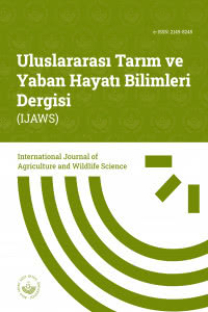Thiadiazuron ve Zeatin’in Helichrysum pallasii’de Bitki Rejenerasyonuna Etkisi
ölmez çiçek, mikro çoğaltım, doku kültürü, Thidiazuran, Zeatin
Effects of Thidiazuran and Zeatin on Plant Regeneration in Helichrysum pallasii
immortal flower, micropropagation, tissue culture, Thidiazuran, Zeatin,
___
- Angioni, A., Barra, A., Arlorio, M., Coisson, J. D., Russo, M. T., Pirisi, F. M., Satta, M., & Cabras, P. (2003). Chemical composition, plant genetic differences, and Antifungal activity of the essential oil of Helichrysum italicum G. Don ssp. microphyllum (Willd) nym. Journal of Agricultural and Food Chemistry, 51(4), 1030-1034.
- Appendino, G., Ottino, M., Marquez, N., Bianchi, F., Giana, A., Ballero, M., Sterner, O., Fiebich, B. L., & Munoz, E. (2007). Arzanol, an anti-inflammatory and Anti-HIV-1 Phloroglucinol α-pyrone from Helichrysum italicum ssp. microphyllum. Journal of Natural Products, 70(4), 608-612.
- Baytop, T. (1986). Farmakognozi Ders Kitabı. Cilt I. İstanbul Üniversitesi Yayınları, No:3399, İstanbul.
- Cragg, G. M., Body, M. R., Cardell, N., Grever, J., Schepartz, M., & Spader, K. (1993). The Role of Plants in the Drug Discovery Program of the US Manupilation. International Crop Science 1 Maddison, USA: Crop Science Society of America.
- Davis, P. H. (1975). Flora of Turkey and the East Aegean Islands. Edinburgh, UK: Edinburgh University Press.
- Davis, P. H., Mill, R. R., & Tan, K. (1988). Flora of Turkey and the East Aegean Islands. Edinburgh, UK: Edinburgh University Press.
- Đorđević, A., Lazarević, J., Šmelcerović, A., & Stojanović, G. (2013). The case of Hypericum rochelii Griseb. and Schenk and Hypericum umbellatum A. Kern. essential oils: Chemical composition and antimicrobial activity. Journal of Pharmaceutical and Biomedical Analysis, 77, 145-148.
- Eröztürk, N. (2000). Bir Yudum Sağlık. Anahtar Kitap Yayınları, İstanbul.
- Farnsworth, N. R. (1993). Ethnopharmacology and future drug development: The North American experience. Journal of Ethnopharmacology, 38(2-3), 137-143.
- Ghasemi Pirbalouti, A., Hashemi, M., & Ghahfarokhi, F. T. (2013). Essential oil and chemical compositions of wild and cultivated Thymus daenensis Celak and Thymus vulgaris L. Industrial Crops and Products, 48, 43-48.
- Giovannini, A., Amoretti, M., Savona, M., Di Guardo, A., & Ruffoni, B. (2003). Tissue Culture in Helichrysum spp. Acta Horticulturae, 616, 339-342.
- Guner, A., Ozhatay, N., Ekim, T., & Baser, K. H. C. (2000). Flora of Turkey and the East Aegean Islands. Edinburgh, UK: Edinburgh University Press.
- Kalogeropoulos, N., Kaliora, A. C., Artemiou, A., & Giogios, I. (2014). Composition, volatile profiles and functional properties of virgin olive oils produced by two-phase vs three-phase centrifugal decanters. Food Science and Technology, 58(1), 272-279.
- Lawrence, B. M. (1998). Helichrysum oil and extract. Perfumer Flavorist, 23(5), 55–59.
- Li, Y., Kong, D., & Wu, H. (2013). Analysis and evaluation of essential oil components of Cinnamon barks using GC–MS and FTIR spectroscopy. Industrial Crops and Products, 41, 269-278
- Machado, D. G., Cunha, M. P., Neis, V. B., Balen, G. O., Colla, A., Bettio, L. E., Oliveira, Á., Pazini, F. L., Dalmarco, J. B., Simionatto, E. L., Pizzolatti, M. G., & Rodrigues, A. L. (2013). Antidepressant-like effects of fractions, essential oil, carnosol and betulinic acid isolated from Rosmarinus officinalis L. Food Chemistry, 136(2), 999-1005.
- Mebatsion, H., Paliwal, J., & Jayas, D. (2012). Evaluation of variations in the shape of grain types using principal components analysis of the elliptic fourier descriptors. Computers and Electronics in Agriculture, 80, 63-70.
- Murashige, T., & Skoog,, F. (1962). A revised medium for rapid growth and bio assays with tobacco tissue cultures. Physiologia Plantarum, 15(3), 473-497.
- Nigg, H. N., & Seigler, D. (1992). Phytochemical Resources for Medicine and Agriculture. Springer, USA.
- Olmedo, R., Nepote, V., & Grosso, N. R. (2014). Antioxidant activity of fractions from oregano essential oils obtained by molecular distillation. Food Chemistry, 156, 212-219.
- Perrini, R., Ruta, C., & Morone Fortunato, I. (2009). Regeneration through organogenesis from leaves of Helichrysum italicum (Roth) G. Don. Acta Horticulturae, 812, 217-222.
- Quassinti, L., Bramucci, M., Lupidi, G., Barboni, L., Ricciutelli, M., Sagratini, G., Papa, F., Caprioli, G., Petrelli, D., Vitali, L. A., Vittori, S., & Maggi, F. (2013). In vitro biological activity of essential oils and isolated furanosesquiterpenes from the neglected vegetable Smyrnium olusatrum L. (Apiaceae). Food Chemistry, 138(2-3), 808-813.
- Rossi, D., Guerrini, A., Paganetto, G., Bernacchia, G., Conforti, F., Statti, G., Maietti, S., Poppi, I., Tacchini, M., & Sacchetti, G. (2013). Croton lechleri Müll. Arg. (Euphorbiaceae) stem bark essential oil as possible mutagen-protective food ingredient against heterocyclic amines from cooked food. Food Chemistry, 139(1-4), 439–447.
- Soković, M., Tzakou, O., Pitarokili, D., & Couladis, M. (2002). Antifungal activities of selected aromatic plants growing wild in Greece. Die Nahrung, 46(5), 317–320.
- Sumbul, H., Gokturk, R. S., & Dusen, O. D. (2003). A new endemic species of Helichrysum Gaertn. (Asteraceae–Inuleae) from south Anatolia. Botanical Journal of the Linnean Society, 141, 251–254.
- ISSN: 2149-8245
- Başlangıç: 2015
- Yayıncı: BOLU ABANT İZZET BAYSAL ÜNİVERSİTESİ > ZİRAAT VE DOĞA BİLİMLERİ FAKÜLTESİ
‘Eşme’ Ayva Çeşidinin Farklı Meyve Kısımlarının Biyoaktif İçerikleri
Orhan KARAKAYA, Mehmet Fikret BALTA
Doğu Anadolu Bölgesi Pyrus elaeagrifolia Pall. Ekotiplerinin Morfolojik Çeşitliliği
Kooperatif Markalı Ürünlere Yönelik Tüketici Tercihleri:Tokat İli Merkez İlçe Örneği*
Hayriye YILDIZ DAŞGAN, Boran İKİZ, Sultan DERE, Musa KILINÇ
Sanayi İşletmecilerince Algılanan Çevre Sorunları ve Nedenleri (TR83 Bölgesi Araştırması)
Hayati GÖNÜLTAŞ, HALİL KIZILASLAN
Tarımsal Uygulamalarda ANSYS Kullanımı: Tarım Arabası Aksı Modellenmesi ve Analizi Örneği
Mehmet Metin ÖZGÜVEN, İsmail TERZİ, Ziya ALTAŞ
Müjde KIRALAN, Muttalip GÜNDOĞDU
Esmanur DEMİREL, Ahmet Naci ONUS
Iğdır’da Doğal Olarak Yetişen İğdelerin (Elaeagnus angustifolia L.) Seleksiyonu
